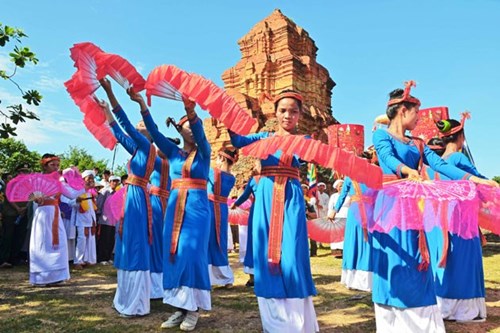
The ethnic Cham Brahman people will hold the Kate festival, their most important event in the year, in the central province of Ninh Thuan from October 19-21.

Cham people in Ninh Thuan celebrate Kate festival
Major activities will take place in temples, towers and central
areas in villages and towns on October 19 morning.
Vice Chairman of the
provincial People’s Committee Le Van Binh said a ceremony to receive a
certificate recognizing the Kate festival as a national tangible heritage will
also be held in Po Klong Garai and Po Rome towers and Po Inungar shrine on October
19 morning.
Director of the
provincial Department of Culture, Sports and Tourism Chau Thanh Hai said
visitors to the event could witness rituals such as a costume procession, the
opening of tower gates, genie statue bathing as well as enjoy Gi Nang drum and
Saranai horn sounds.
Falling on the first day
of the seventh month of the Cham calendar, Kate is the most popular Cham
festival in Ninh Thuan. It reminds the ethnic Brahman community of their
ancient gods and delivers wishes for bumper harvests and the growth of all
beings.
The Cham people have
several distinctive festivals including the Ramuwan, the Rija Nugar, and the
Chabun.
There are about 153,000
Cham people in Vietnam, including approximately 72,500 people in Ninh Thuan.
Over 43,000 of them, scattered across 12 communes in seven districts, follow
the Brahmin religion.
Source:
PANO
With an increasingly vibrant and widespread emulation movement aimed at building cultured residential areas and cultured families, Yen Thuy District has been making steady progress toward improving both the material and spiritual well-being of its people, while fostering a civilized, prosperous, beautiful, and progressive community.
Once lacking recreational spaces and community facilities, Residential Group 2 in Quynh Lam Ward (Hoa Binh City) has recently received attention for the construction of a new, spacious, and fully equipped cultural house. The project followed the model of state support combined with public contributions in both labor and funding.
The "All people unite to build cultural life" movement, which has been effectively integrated with Kim Boi district’s socio-economic development goals, is fostering a lively spirit of emulation across local residential areas, hamlets, villages, public agencies, and enterprises. In addition, through the initiative, traditional cultural values are being preserved and promoted, while community solidarity and mutual support in poverty reduction and economic development are being strengthened.
A working delegation of the Hoa Binh provincial People’s Committee led by its Permanent Vice Chairman Nguyen Van Toan on June 11 inspected the progress of a project to build the Mo Muong Cultural Heritage Conservation Space linked to tourism services in Hop Phong commune, Cao Phong district.
Born and growing in the heroic land of Muong Dong, Dinh Thi Kieu Dung, a resident in Bo town of Kim Boi district, in her childhood was nurtured by the sweet lullabies of her grandmother and mother. These melodies deeply imprinted on her soul, becoming an inseparable part of her love for her ethnic group's culture. For over 20 years, this love for her hometown has driven Dung to research, collect, and pass down the cultural values of the Muong people to future generations.
In the final days of May, the Ethnic Art Troupe of Hoa Binh Province organized performances to serve the people in remote, mountainous, and particularly disadvantaged areas within the province. These were not just ordinary artistic shows, but they were the meaningful journeys aimed at spreading cultural values, enhancing the spiritual life of the people and contributing to the preservation of ethnic minority cultural identities.



